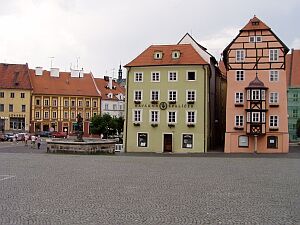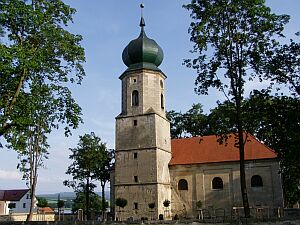Official Name
Cheb. Be aware that 'ch' is pronounced as the 'ch' in the Scottish word 'loch' (phonetical symbol: x). The German name for the town is Eger, and therefore the area around Cheb is called Egerland. There is a river with the same name.
Location

| ||
| Cheb |
Cheb is located in the westernmost tip of the Czech republic, some 150 km away from →Prague. It's only a few kilometers to the German border. The town stretches along the valley of small Ohře (Eger) river, which is coming from Bavaria and continuing to the north-east, where it flows into the Labe (Elbe) river at →Litoměřice. Cheb is surrounded by mountains and enjoys the neigbourhood of two large reservoirs.
Population
Around 33,000 inhabitants - Cheb is a rather small town.
Orientation
Some 32,000 people live in Cheb - many of them in grey concrete housing areas north of the centre. The historical centre shows a distinctive German influence and mainly stretches between the long náměstí krále Jiřího z Poděbrad (King George of Podebrad - square) and the hidden em>Chebský hrad (Cheb castle). Behind the castle there is the deep valley of Ohře (Eger) river. All in all four churches dominate the city centre - two behind the central square, another two south of the square. Here and there, remains of the old city wall can still be seen.
The surprisingly ugly Cheb nádraží (train station) is quite away from the centre but still accessible on foot. From there, it's possible to walk down třída Svobody (freedom street) northwards - a not very attractive pedestrian zone with some shops and cafés. After around 10 minutes, you will see the central square in front of you. The bus terminal is adjacent to the train station.
Due to the fact that Cheb is very close to Germany, some dubious 'asia markets' settled south of the centre. For a handful of euros, you may buy kitschy garden gnomes, faked DVD's, clothes, alcohol and so on - you name it. There's also a large Kaufland supermarket some hundred meters right of the train station. The city has got a very bad reputation as a place for prostitution. Even underaged streetwalkers can be seen along the city's exit roads. A sad view, which hopefully vanishes within the next years (some measures seem to have been taken).
History
Cheb has a long and interesting history with tragic turns. It was first mentioned in the year 1061 and eversince a German city. This changed in 1322, when Cheb was handed over to the Bohemian kings. A castle was built in the 12th century with parts of it being preserved until today (for more details see sights below). The centre consisted of many old burgher houses, Jewish trading buildings and some churches. Cheb played a very important role during the 30 years' war. In 1634, the famous general Albrecht Wallenstein was murdered in his private house at the market square, because he fell out of favour with the emperor. The house is called Pachhölbelsches and is used as the city museum nowadays.
Cheb has always been a strategically important border town. In the 17th and 18th century, baroque architecture had been introduced and still dominates the city centre. At that time, the baroque architect Baltasar Neumann, one of Cheb's most famous sons, was born. Since the beginning of the Habsburg reign, Cheb was a local centre of Sudeten Germans cultivating their own distinctive dialect. Today, Cheb is very popular with German and Dutch tourists with positive as well as negative consequences. However, the city is trying hard to improve its image. A few years ago, Cheb was declared the centre of Euroregion Egrensis, an area around Cheb including German communities. It will be interesting to see how the EU membership, gained in spring 2004, will change the town.
Getting there / transportation
By bus, train or car. The so-called Vogtlandbahn runs from Plauen (Saxony) via Cheb to Marktredwitz in Bavaria. Bicycles can be transported on the train. The cheap discount ticket 'Schöne-Wochenende-Ticket' (only valid during the weekend and on local trains for up to 5 persons) can be used. A faster train from Nuremberg to →Prague stops in Cheb as well. Several trains a day leave for →Karlovy Vary or Plzeň. However, to go to Prague is awkwardly time-consuming. Although not really far, it takes three hours and more to get there. It might be better to go by bus.
There is a motorway-like modern road leading to the German border crossing at Schirnding. It doesn't take longer than 10 minutes by car to get there.
The historical centre is very compact and so everything is within walking distance. It's best to start at the above-mentioned náměstí krále Jiřího z Poděbrad (King George of Podebrad - square), a long square in the centre, which is actually a huge slope. At the northern tip and almost in the middle of the square, there are two rows of cock-eyed houses and a very narrow street (less then 2 m wide) inbetween. This beautiful ensemble (see photo) is called Špalíček, which means something like 'small annex'. The mainly gothic houses were built during the 13th century. From the 16th century, Jewish merchants lived in the small houses. All of them are very well preserved.

| ||
| The Špalíček in the centre of Cheb |
When passing the spalicek on the right, one will end up in a churchyard, which is almost completely encircled with small dwelling houses. The kostel sv. Mikuláš (St. Niclas church) stands in the middle, a gothic structure with romanesque influenced twin towers. Parts of the church are from the 13th century. Especially the glass paintings are very interesting. Next to the church, above-mentioned city museum can be found.
When diagonally walking left of the Špalíček, you will get to the romanesque fortress Chebský hrad towering the river valley. The characteristic black tower is easy to spot. After crossing the bridge spanning the moat, you will get onto the court of the half-destroyed castle. There, some cannons and an excavation site are on display. Additionally, there is an interesting chapel from the 12th century. The black (because tared) tower is from the year 1222 and offers a great view over the town from the top. The museum is interesting as well - a part of it is dedicated to the Egerland (i.e. Sudeten German) culture. Admission fee to the entire complex is 40 kč (students 20).
The surroundings of Cheb offer many interestung places. Nearby, two large reservoirs attract the citizens as well as many other tourists: the one in the west is called Skalka reservoir and almost stretches all the way to the German border. The other one in the east is called Jesenice reservoir with hills, fields and forests in the vicinity. A perfect place for camping (see accommodation). Both reservoirs are full of fish, and so fish belongs to the staple diet of restaurants near the lake. Both lakes are only 3 km away from Cheb.

| ||
| Baroque (formerly romanesque) church in Dřenice |
Less then 10 km in the north, Františkovy Lázně (Franzensbad) is a very popular spa with some 9 to 12 degrees Celsius mineral springs. The baroque centre and the adjacent park are very beautiful and make it a perfect destination for a day trip.
A few kilometers south-east of Františkovy Lázně, the nature reserve Soos awaits the nature-interested visitor. The area is 221 hectare big. It's claim to fame are numerous mofettes (mud volcanoes), where carbon dioxide bubbles up through thick layers of differently coloured mud. All in all a very strange scenery which is worth an extensive walk.
Kynšperk nad Ohři (Königsberg a. d. Eger) is a small town around 15 km east of Cheb with a beautiful fortress built in 1188. This place is also worth a short visit.
There are a few camping sites near the reservoirs. You can get there by bus, car or bicycle. However, buses are not very frequent. The camping season starts in May and ends in September. The camping sites are usually well equipped with restaurants, playgrounds, small shops and so on. Especially during Dutch and German bank holidays, e.g. Whitsun, most camping sites are completely booked out. Personally I can recommend Dřenice (Drenice) camping on the shore of Jesenice reservoir. It's only 4 km away from the city centre and the facilities, incl. volleyball and tennis courts etc, are okay. A tent or trailer and car cost 190 Kč per night, additionally campers pay 30 Kč per person. There's another camping site at the northern tip of the same reservoir, which is better to be avoided.
At the southern end of the central place in Cheb, the Hotel Hvězda offers some old-fashioned but clean rooms. A bed in a double with shared toilet and bathroom costs 15 € per night. There is a restaurant downstairs. Of course it's also possible to stay in pensions. Just refer to the tourist information at nám. krále Jiřího z Poděbrad.
- www.mestocheb.cz Official and quite useful website of Bled with plenty of infomation related to tourism. Comes in English, Czech and German.
Do you have or do you know a good website about Cheb? Don't hesitate, let me know! After checking it, I would love to add it to the link list. You can submit a link by using the →contact form. Note that commercial websites will be treated differently.
©2024 Europe-East.com

 Albania
Albania Czech Republic
Czech Republic